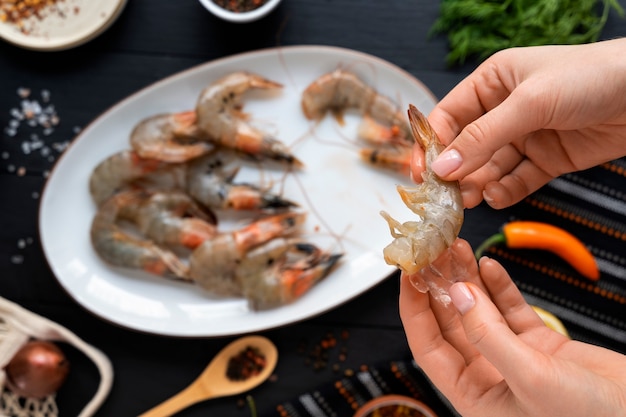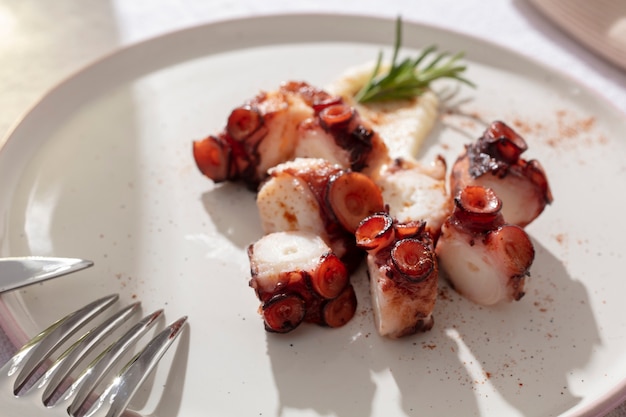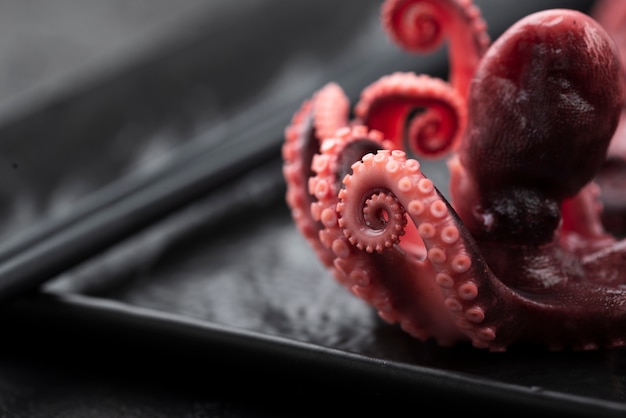I've always been drawn to octopuses – those eight-armed enigmas that seem to defy logic with their camouflage skills and intelligence. And while I've long admired them from afar, the thought of cooking one always filled me with a sense of intimidation. It felt like a culinary Everest, a challenge reserved for experienced chefs. But, a couple of years ago, I decided to conquer my fear and delve into the world of octopus cooking. It's been an incredible journey, filled with both triumphant successes and a few burnt tentacles along the way. Now, I'm ready to share everything I've learned, so you too can experience the magic of this versatile and delicious cephalopod.
This guide is more than just a collection of recipes; it's a culinary exploration that will equip you with the confidence to tackle octopus cooking head-on. From finding the perfect specimen to mastering tenderising techniques and discovering a world of flavour pairings, I'll walk you through every step, sharing my own experiences and offering advice based on countless hours spent in the kitchen. So, gather your ingredients, put on your apron, and let's embark on this delicious adventure together.
(Part 1) Finding Your Perfect Octopus

The journey begins with selecting the right octopus. It's the foundation of a delicious dish, and choosing a fresh, high-quality octopus is crucial. You might be thinking, “Where on earth do I find an octopus?” Don’t worry, it’s not as daunting as you think.
Where to Buy
While octopuses might not be a staple in every supermarket, they’re becoming more readily available. Here’s where to look:
- Fishmongers: Your best bet is a good old-fashioned fishmonger. They're the experts! They’ll help you choose the right octopus for your recipe and often prepare it for you – a real time-saver, especially for beginners like I once was.
- Supermarkets: Larger supermarkets often carry frozen octopus. It's not as ideal as fresh, but it's a decent option if you can't find fresh. Just ensure it's properly frozen and handled.
- Online: In a pinch, online retailers can be your lifeline. However, do your research and choose a reputable supplier with a reliable shipping process. You want your octopus to arrive fresh and in good condition.
Choosing the Right Size
The size of your octopus matters! Smaller octopus (around 1-2 pounds) are perfect for grilling or sautéing – they cook quickly and are less intimidating to handle. Larger octopuses (3-4 pounds or more) are ideal for braising or stewing, offering a more substantial experience. I've learned that smaller octopuses tend to have a more delicate flavor, while larger ones develop deeper, richer flavors during longer cooking times.
Checking for Freshness
The ultimate test is in the details. Look for a fresh octopus with:
- Bright, vibrant skin: A healthy octopus will have skin that's not discolored or dull.
- Firm flesh: The flesh should feel firm to the touch, not mushy or slimy.
- Mild, slightly salty scent: A fresh octopus will have a subtle, ocean-like smell. Avoid anything with a strong, fishy odor.
(Part 2) The Art of Tenderising

Octopuses are known for their tough, rubbery texture, which can be off-putting if not addressed properly. That’s where tenderising comes in – the crucial step that transforms a potentially chewy creature into a culinary delight. It's a bit like a culinary alchemy, turning something seemingly unyielding into something melt-in-your-mouth delicious.
Traditional Tenderising Methods
These tried-and-true techniques have been used for centuries, relying on physical manipulation and patience to break down those tough muscle fibers.
- Tenderising with a mallet: A classic approach that involves pounding the octopus with a meat mallet. It can be a bit messy, but it effectively breaks down those tough muscle fibers. It's a good way to relieve tension too! Just imagine all that frustration going into a more tender octopus.
- Tying and Boiling: This method involves tightly tying the octopus with string and then boiling it for an extended period. This helps break down the tough fibers and ensures even cooking. I learned this from an old Italian fisherman who taught me the art of tying the octopus so it cooks perfectly. It's a bit of a skill, but worth the effort – the results are amazing.
Modern Tenderising Techniques
Over time, chefs and home cooks have devised clever methods using modern kitchen tools and techniques to tenderise octopus.
- slow cooker: A fantastic option for busy cooks. Simply place the octopus in the slow cooker with some aromatics and let it cook on low heat for several hours. The slow, gentle heat breaks down the muscles, resulting in incredibly tender octopus. I love this method when I’m short on time, because it’s hands-off! I can go about my day while the octopus cooks to perfection.
- pressure cooker: For a faster approach, a pressure cooker is a game-changer. It uses high pressure and steam to cook the octopus quickly and efficiently, resulting in a tender and juicy final product. It’s not just about speed, it’s about saving energy and preserving the octopus’s natural flavors.
(Part 3) Cleaning and Preparing Your Octopus

Now that you’ve got your octopus home, it's time to prep it for cooking. This might seem daunting, but it’s actually pretty simple. Think of it as a mini-adventure – a culinary exploration of the octopus itself.
Cleaning the Octopus
If you bought your octopus fresh from the fishmonger, it might already be cleaned. But if not, you'll need to give it a good scrub.
- Remove the beak: The beak is a hard, pointed structure located in the center of the octopus’s head. You can remove it by twisting it off or using a sharp knife. This might sound a bit intimidating, but it’s really not that bad.
- Remove the eyes: They’re located on the top of the octopus’s head. Simply pull them out with your fingers.
- Clean the ink sac: The ink sac is near the head and contains black ink that can be used to color sauces. If you don't want to use the ink, carefully remove the sac and discard it. A little bit of ink can add a nice depth of flavor to some dishes, but it's definitely not for everyone.
- Wash thoroughly: Once you’ve removed the beak, eyes, and ink sac, wash the octopus thoroughly under cold running water to remove any remaining debris.
Cutting the Octopus
How you cut your octopus will depend on your recipe. Here are some common methods:
- Whole: If you’re braising or stewing your octopus, you can leave it whole. It's a good way to cook a large octopus, ensuring even cooking throughout.
- Tentacles: For grilling, sautéing, or serving as tapas, you can cut the octopus into individual tentacles. This gives you nice bite-sized portions.
- Sliced: If you’re using the octopus in a salad or stir-fry, you can slice it into thin pieces. This helps it cook quickly and absorb the flavors of the other ingredients.
(Part 4) Cooking Your Octopus: A Symphony of Flavors
With your octopus prepped and ready, it's time to unleash your creativity! There’s a world of possibilities when it comes to cooking octopus, from classic stews to bold grilled dishes. I've tried so many different things over the years, and it never ceases to amaze me how versatile this ingredient is.
Classic Octopus Stew: A Rich, Comforting Dish
A traditional octopus stew is a true comfort food. It's bursting with flavor, with the octopus cooked until it's incredibly tender. It’s a heartwarming dish that warms you from the inside out.
Ingredients:
- 1 kilogram octopus
- 2 onions, chopped
- 2 celery stalks, chopped
- 2 carrots, chopped
- 2 cloves garlic, minced
- 1 cup white wine
- 2 cups chicken broth
- 1 (14.5 ounce) can diced tomatoes, undrained
- 1/2 teaspoon dried oregano
- 1/4 teaspoon black pepper
- 1/4 cup chopped fresh parsley, for garnish
Instructions:
- In a large pot or dutch oven, combine the octopus, onions, celery, carrots, garlic, white wine, chicken broth, diced tomatoes, oregano, and pepper. Bring to a boil over high heat, then reduce heat to low, cover, and simmer for 2-3 hours, or until the octopus is very tender.
- Before serving, garnish with chopped parsley.
Grilled Octopus: A Smoky, Charred Delight
Grilled octopus is a delicious and impressive dish. It combines the smoky flavor of grilling with the tender, juicy texture of the octopus. It’s a show-stopper, perfect for entertaining guests or simply enjoying a delicious meal on a warm evening.
Ingredients:
- 1 kilogram octopus, tentacles separated
- 1/4 cup olive oil
- 1 tablespoon lemon juice
- 1 tablespoon chopped fresh oregano
- 1/2 teaspoon salt
- 1/4 teaspoon black pepper
Instructions:
- In a large bowl, combine the octopus tentacles, olive oil, lemon juice, oregano, salt, and pepper. Toss to coat evenly.
- Preheat your grill to medium-high heat.
- Grill the octopus tentacles for 3-4 minutes per side, or until charred and cooked through.
(Part 5) Flavourful Sauces and Accompaniments
Octopus is a chameleon in the culinary world, taking on the flavors of its companions. Here are some ideas for sauces and accompaniments to elevate your octopus dishes.
Sauces
- Aioli: Aioli is a creamy garlic sauce that’s perfect for grilled or roasted octopus. It adds a pungent, savory note that complements the octopus’s natural flavor. It’s a classic pairing for a reason!
- Romesco Sauce: This vibrant, nutty sauce is a traditional Catalan specialty. It's made with roasted red peppers, almonds, tomatoes, and garlic, and it adds a bright, smoky dimension to octopus dishes. It's a beautiful marriage of sweet, smoky, and savory flavors.
- Lemon-Herb Sauce: A simple lemon-herb sauce is a classic accompaniment to octopus. It's light and refreshing, and it balances the richness of the octopus. The acidity of the lemon cuts through the richness, while the herbs add a lovely fragrance.
Accompaniments
- grilled vegetables: Grilled vegetables, such as zucchini, peppers, and onions, are a perfect complement to octopus. They add a burst of color and flavor to the dish. The smoky char from the grill complements the octopus beautifully.
- Roasted Potatoes: Roasted potatoes add a hearty and comforting element to any octopus dish. They absorb the flavors of the octopus and create a satisfying meal. The simple flavors of roasted potatoes are a perfect foil to the octopus.
- Couscous: Couscous is a light and fluffy grain that complements octopus well. It absorbs the flavors of the sauce and provides a contrasting texture. The fluffy texture of couscous contrasts nicely with the tender octopus.
(Part 6) The Art of Presentation: Making Your Octopus Shine
As they say, “You eat with your eyes first,” and that's definitely true with octopus. A beautifully presented octopus dish can transform a simple meal into a culinary masterpiece. It's about making the octopus the star of the show.
Plating Ideas
- Rustic Charm: Use a rustic platter or wooden board for a more casual and homey feel. Arrange the octopus tentacles artfully, and garnish with fresh herbs and vegetables. It gives the dish a down-to-earth vibe that’s perfect for sharing with friends and family.
- Modern Elegance: Opt for a clean, modern plate. Use a minimalist approach, focusing on the octopus as the main attraction. Add a small splash of sauce and a few sprigs of herbs for a touch of elegance. It’s all about simplicity and letting the octopus shine.
- Bold Colors: Use a contrasting color plate to make the octopus stand out. A vibrant red or blue plate will create a visual impact and make your dish more appealing. It’s a great way to add a pop of color to your table.
Garnishes
Garnishes are the finishing touch that adds visual appeal and elevates your octopus dish. They’re like the jewelry for your culinary masterpiece.
- Fresh Herbs: Parsley, cilantro, dill, and chives all add a pop of color and freshness to the dish. They also add a wonderful fragrance that enhances the overall experience.
- Citrus Zest: A sprinkle of lemon or orange zest adds a bright, citrusy flavor and a beautiful visual touch. It’s a great way to add a touch of acidity and a burst of flavor.
- Smoked Paprika: This adds a warm, smoky flavor and a vibrant red hue to the dish. It adds a depth of flavor and a beautiful visual contrast.
(Part 7) A culinary journey Beyond the Plate
Octopus isn't just a delicious ingredient; it's a doorway to different cultures and culinary traditions. Exploring different cuisines can expand your culinary horizons and offer new ways to enjoy octopus. It's a culinary adventure that takes you around the world.
Octopus Around the World
- Spain: In Spain, octopus is a staple of tapas culture. It's often grilled, sautéed, or braised with garlic, paprika, and olive oil. It's a classic Spanish tapas dish that’s always a crowd-pleaser.
- Italy: In Italy, octopus is used in various dishes, from stews and salads to pasta sauces. It's often cooked with tomatoes, onions, and herbs. The Italians have a knack for simple yet flavorful dishes.
- Greece: Greek cuisine features octopus in a variety of dishes, including salads, stews, and grilled platters. It's often flavored with lemon, olive oil, and oregano. The Mediterranean flavors are simply divine.
- Korea: Octopus is a popular ingredient in Korean cuisine, often served as a spicy stir-fry or in a variety of soups. The Koreans have a taste for bold flavors and interesting textures.
Exploring New Flavors
Don't be afraid to experiment with different spices, herbs, and cooking techniques to create your own unique octopus dishes. Try adding a touch of curry powder for a hint of Indian spice, or use a Moroccan blend of spices for a warm and fragrant dish. The possibilities are endless, so get creative and have fun with it!
(Part 8) Octopus: A Sustainable and Delicious Choice
As a conscious eater, I always consider the sustainability of the ingredients I use. Octopus, when sourced responsibly, is a great choice for a sustainable meal. It’s all about making choices that respect our planet and its resources.
Choosing Sustainable Octopus
- Ask your fishmonger: A good fishmonger will be able to tell you about the origin of their octopus and how it was caught. Look for octopus that's been caught using sustainable fishing methods. They should be able to explain their sourcing practices.
- Look for certifications: Some organizations, such as the Marine Stewardship Council (MSC), certify sustainable seafood. Look for octopus that carries these certifications. It's a good way to be sure that the octopus you're buying comes from a well-managed fishery.
- Support local fishers: Buying octopus from local fishers helps to support sustainable fishing practices in your community. It's a great way to connect with your local food system and contribute to a more sustainable future.
The Importance of Conservation
Overfishing is a serious threat to octopus populations. By making informed choices about the octopus we buy, we can help to ensure that future generations can enjoy this delicious and fascinating creature. It's a matter of preserving not just a food source but also a part of our planet's biodiversity.
FAQs
What are the best ways to tell if an octopus is fresh?
Freshness is key! Look for a vibrant, unblemished appearance, firm flesh, and a mild, slightly salty scent. Steer clear of any octopus that appears discolored, slimy, or has a strong fishy odor.
How long can I store an octopus in the refrigerator?
You can store fresh octopus in the refrigerator for 1-2 days. If you're not planning to cook it within that timeframe, it's best to freeze it.
Can I freeze octopus?
Yes, you can freeze octopus. To freeze it properly, wrap it tightly in plastic wrap and place it in a freezer-safe bag. You can freeze octopus for up to 3 months. When you’re ready to use it, defrost it in the refrigerator overnight.
How long does it take to cook octopus?
The cooking time for octopus depends on the size and method of cooking. A smaller octopus might only take 30-45 minutes to cook, while a larger octopus could take several hours. For example, a pressure cooker might cook a smaller octopus in under an hour, but a large octopus will take much longer in a slow cooker.
What are some tips for making octopus tender?
To achieve that tender, melt-in-your-mouth texture, you need to break down those tough muscle fibers. Try traditional methods like tenderising with a mallet or tying and boiling, or embrace modern techniques like slow cooking or pressure cooking. Experiment and find what works best for you! Remember, practice makes perfect.
With this guide as your companion, you're ready to become a master octopus chef. Don’t be afraid to experiment, embrace patience, and have fun. And most importantly, never stop exploring! Happy cooking!
Everyone is watching

Prime Rib Roast Cooking Time Chart: Per Pound Guide
Cooking TipsPrime rib roast. Just the name conjures images of lavish dinners, crackling fires, and hearty laughter. It’s ...

How Long to Bake Potatoes in the Oven (Perfect Every Time)
Cooking TipsBaked potatoes are a staple in my kitchen. They're incredibly versatile, delicious, and surprisingly easy to m...

Perfect Rice Every Time: The Ultimate Guide to Cooking Rice
Cooking TipsAs a self-proclaimed foodie, I've always been a bit obsessed with rice. It's the foundation of countless cuisi...

The Ultimate Guide to Cooking Asparagus: Tips, Techniques, and Recipes
Cooking TipsAsparagus. The mere mention of this spring delicacy conjures up images of vibrant green spears, crisp and burs...

Ultimate Guide to Cooking the Perfect Thanksgiving Turkey
Cooking TipsThanksgiving. Just the word conjures up images of overflowing tables laden with delicious food, the scent of r...
